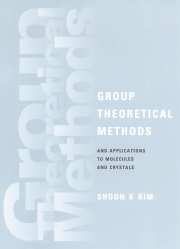Book contents
- Frontmatter
- Contents
- Preface
- List of symbols
- 1 Linear transformations
- 2 The theory of matrix transformations
- 3 Elements of abstract group theory
- 4 Unitary and orthogonal groups
- 5 The point groups of finite order
- 6 Theory of group representations
- 7 Construction of symmetry-adapted linear combinations based on the correspondence theorem
- 8 Subduced and induced representations
- 9 Elements of continuous groups
- 10 The representations of the rotation group
- 11 Single- and double-valued representations of point groups
- 12 Projective representations
- 13 The 230 space groups
- 14 Representations of the space groups
- 15 Applications of unirreps of space groups to energy bands and vibrational modes of crystals
- 16 Time reversal, anti-unitary point groups and their co-representations
- 17 Anti-unitary space groups and their co-representations
- Appendix Character tables of the crystal point groups
- References
- Index
7 - Construction of symmetry-adapted linear combinations based on the correspondence theorem
Published online by Cambridge University Press: 12 November 2009
- Frontmatter
- Contents
- Preface
- List of symbols
- 1 Linear transformations
- 2 The theory of matrix transformations
- 3 Elements of abstract group theory
- 4 Unitary and orthogonal groups
- 5 The point groups of finite order
- 6 Theory of group representations
- 7 Construction of symmetry-adapted linear combinations based on the correspondence theorem
- 8 Subduced and induced representations
- 9 Elements of continuous groups
- 10 The representations of the rotation group
- 11 Single- and double-valued representations of point groups
- 12 Projective representations
- 13 The 230 space groups
- 14 Representations of the space groups
- 15 Applications of unirreps of space groups to energy bands and vibrational modes of crystals
- 16 Time reversal, anti-unitary point groups and their co-representations
- 17 Anti-unitary space groups and their co-representations
- Appendix Character tables of the crystal point groups
- References
- Index
Summary
Introduction
In the eigenvalue problem of a Hamiltonian in quantum mechanics, the eigenfunctions of the Hamiltonian are classified in terms of the unitary irreducible representations (unirreps) of the symmetry group G of the Hamiltonian. In constructing approximate eigenfunctions by LCAO-MOs of a molecule belonging to a certain symmetry group G, the corresponding problem is to find the irreducible basis sets of G constructed by the linear combinations of the atomic orbitals belonging to the equivalent atoms of the molecule. Such a set is called a set of symmetry-adapted linear combinations (SALC) of the equivalent basis functions or equivalent orbitals. A standard method for such a problem is the generating operator method introduced in Section 6.9: it generates the desired basis set from an appropriate basis function. This method is very general and powerful but it is often extremely laborious to use; Cotton (1990). It is so very formal that one has little feeling until one arrives at the final result, which often could simply be obtained by inspection.
For point groups and their extensions, there exists a simple direct method of constructing the SALC belonging to a unirrep of a symmetry group G. The method requires knowledge of the basis functions of a space vector r = (x, y, z) in three dimensions belonging to the unirrep. The basis sets are well known for all point groups; e.g., those for the point groups Tp and D3p are reproduced in Tables 7.1 and 7.2, respectively, from the Appendix.
- Type
- Chapter
- Information
- Publisher: Cambridge University PressPrint publication year: 1999

